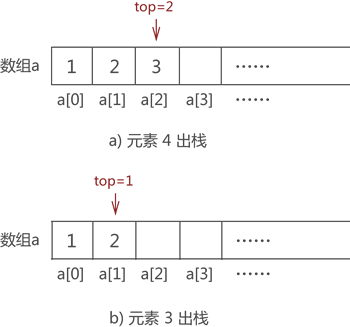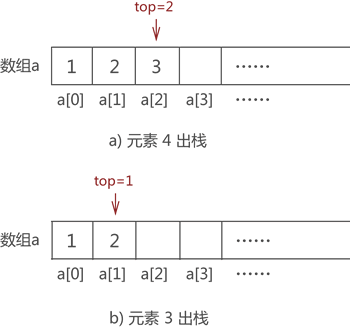C语言数据结构栈实现-顺序栈
顺序栈,即用顺序表实现栈存储结构。通过前面的学习我们知道,使用栈存储结构操作数据元素必须遵守 "先进后出" 的原则,本节就 "如何使用顺序表模拟栈以及实现对栈中数据的基本操作(出栈和入栈)" 给大家做详细介绍。
如果你仔细观察顺序表(底层实现是数组)和栈结构就会发现,它们存储数据的方式高度相似,只不过栈对数据的存取过程有特殊的限制,而顺序表没有。
例如,我们先使用顺序表(a 数组)存储 {1,2,3,4},存储状态如图 1 所示:

同样,使用栈存储结构存储 {1,2,3,4},其存储状态如图 2 所示:

通过图 1 和图 2 的对比不难看出,使用顺序表模拟栈结构很简单,只需要将数据从 a 数组下标为 0 的位置依次存储即可。
从数组下标为 0 的模拟栈存储数据是常用的方法,从其他数组下标处存储数据也完全可以,这里只是为了方便初学者理解。
了解了顺序表模拟栈存储数据后,接下来看如何模拟栈中元素出栈的操作。由于栈对存储元素出栈的次序有"先进后出"的要求,如果想将图 1 中存储的元素 1 从栈中取出,需先将元素 4、元素 3 和元素 2 依次从栈中取出。
这里给出使用顺序表模拟栈存储结构常用的实现思路,即在顺序表中设定一个实时指向栈顶元素的变量(一般命名为 top),top 初始值为 -1,表示栈中没有存储任何数据元素,及栈是"空栈"。一旦有数据元素进栈,则 top 就做 +1 操作;反之,如果数据元素出栈,top 就做 -1 操作。
顺序栈元素"入栈"
比如,还是模拟栈存储 {1,2,3,4} 的过程。最初,栈是"空栈",即数组是空的,top 值为初始值 -1,如图 3 所示:

首先向栈中添加元素 1,我们默认数组下标为 0 一端表示栈底,因此,元素 1 被存储在数组 a[1] 处,同时 top 值 +1,如图 4 所示:

采用以上的方式,依次存储元素 2、3 和 4,最终,top 值变为 3,如图 5 所示:

顺序栈元素"出栈"
其实,top 变量的设置对模拟数据的 "入栈" 操作没有实际的帮助,它是为实现数据的 "出栈" 操作做准备的。
比如,将图 5 中的元素 2 出栈,则需要先将元素 4 和元素 3 依次出栈。需要注意的是,当有数据出栈时,要将 top 做 -1 操作。因此,元素 4 和元素 3 出栈的过程分别如图 6a) 和 6b) 所示:


注意,图 6 数组中元素的消失仅是为了方便初学者学习,其实,这里只需要对 top 值做 -1 操作即可,因为 top 值本身就表示栈的栈顶位置,因此 top-1 就等同于栈顶元素出栈。并且后期向栈中添加元素时,新元素会存储在类似元素 4 这样的旧元素位置上,将旧元素覆盖。
代码实现
//顺序栈
#include <stdlib.h>
#define MaxSize 5
int pushstack(int * stack, int head, int elem){
stack[head] = elem;
head = head-1;
return head;
}
int popstack(int * stack , int head){
int temp = head-1;
int data = stack[temp];
printf("this is data is %d\n", data);
return head+1;
}
void stackprint(int * stack){
for(int i=0;i<MaxSize;i++){
printf("%d\n",stack[i]);
}
}
int main()
{
int Stack[MaxSize]={0};
int head = MaxSize-1;
int bottom = head;
head = pushstack(Stack,head,1);
head = pushstack(Stack,head,2);
head = pushstack(Stack,head,3);
head = pushstack(Stack,head,4);
head = pushstack(Stack,head,5);
head=1;
head = popstack(Stack,head);
head = popstack(Stack,head);
stackprint(Stack);
return(0);
}
链表栈实现代码
#include <stdlib.h>
#include<stdio.h>
typedef struct Node {
int data;
int * next;
} Node;
pushStack(Node * head, int elem){
Node * tempbody = head;
while(tempbody->next != NULL){
tempbody= tempbody->next;
}
Node * newNode = (Node *) malloc(sizeof(Node));
newNode->data = elem;
tempbody->next = newNode;
}
void popStack(Node * head){
Node * tempbody = head->next;
Node * prev = NULL;
while(tempbody->next != NULL){
prev = tempbody;
tempbody = tempbody->next;
}
printf("this is data is %d\n",tempbody->data);
prev->next = NULL;
}
void printStack(Node * head){
Node * tempbody = head->next;
while(tempbody != NULL){
printf("%d\n",tempbody->data);
tempbody = tempbody->next;
}
}
int main()
{
Node * headNode = (Node *) malloc(sizeof(Node));
pushStack(headNode,1);
pushStack(headNode,2);
pushStack(headNode,3);
pushStack(headNode,4);
pushStack(headNode,5);
pushStack(headNode,6);
popStack(headNode);
popStack(headNode);
printStack(headNode);
return(0);
}



